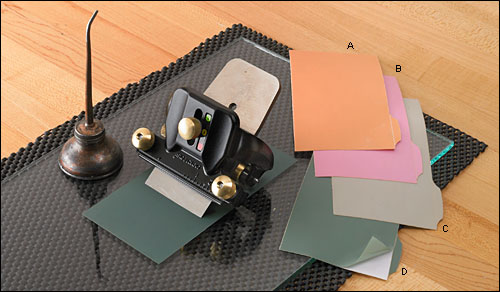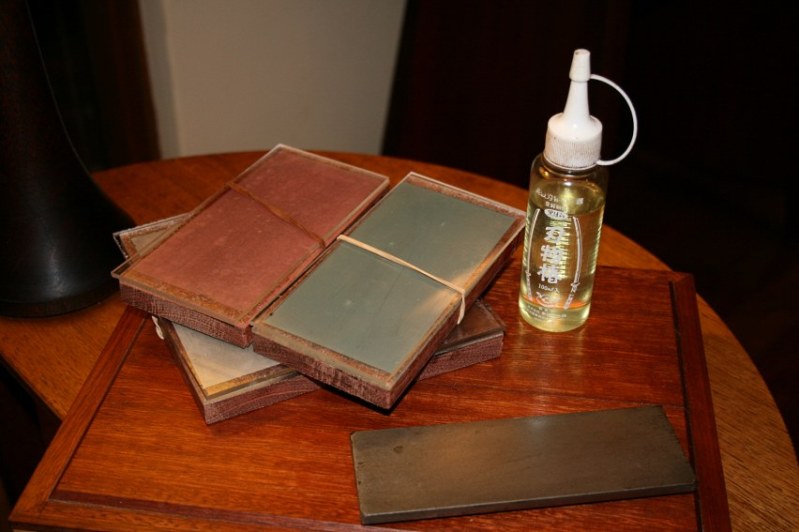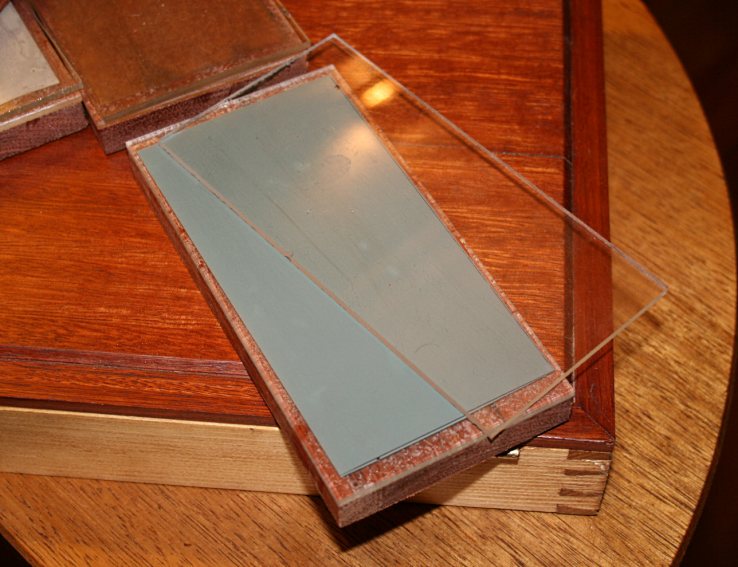
Diamond Lapping Film
Lee Valley is now selling lapping film made from monocrystalline diamond particles attached to 3" x 6" PSA-backed polyester sheets.
I had the opportunity to get to know these films, working with LV through a wad of different grits to narrow down the micron progression, and trying to get a fix on their longevity.

Lee Valley catalogue: http://www.leevalley.com/US/wood/page.aspx?p=68943&cat=1,43072
A
6"x3" mesh is large enough for
either freehanding or a guide. The films act like diamond plates -
there is no cross contamination. The diamond film requires very
little "movement" to do its job. I did not experience an
issue with dubbing. It is unlike sandpaper - it is very flat and on a
hard backing. Be sure that you clean the substratum well - dust below
will create a bump, which will end up being sliced. One way to
attach the film to glass is to float it on with a soapy water mix.
Once the water evaporates, the film will lie flat.
The
meshes chosen (15/3/.5/.1micron) allow for the least extra wear on
each successive mesh ... in other words, the most efficient use of
each mesh. You could forgo the 0.1
µ if
you wish, but I must say that the addition of this takes the
sharpening level to something well beyond "scary" ...
frightening sharp.
At
the start I used water to lubricate and carry away the swarf. This
was recommended by LV. I quickly changed this to
water-plus-detergent, which was a big improvement. Later I suggested
Camellia
oil, which was an even bigger improvement.
Testing
the films on softer steels is a lot like testing plane blades on
straight-grained woods - it is less likely that you will find
important differences when the conditions are easy. Using
harder/abrasion-resistant steels really shows up the potential of
these films. They work just as well on the O1 and A2 steels, but then
the differences with a Shapton or even an oilstone will be reduced
significantly.
The
combination of film-plus-oil has quite a different feel to a
waterstone-plus-water. Even more so along the spectrum is a cast iron
plate with impregnated diamond paste. These are hard and slippery -
very little feedback. Waterstones, even the hard ceramic stones,
offer more feedback. My old Kings, which were quite soft, gave lots
of feedback.
The
films are amazing in their ability to hone steel, and in their
longevity. I have some that have been through at least a hundred
cycles (per piece).
I
really would not consider the diamond film for " taking care of
a nick". This is the weak point of the film - it is vulnerable
to being cut. Avoid contact with ragged edges . The film is best for
dull blades, not damaged edges.
The
film is
not suitable for a primary sharpening system.
Film
- including sandpaper - although a fairly modest outlay, ends up
being expensive. They wear out and need to be replaced, and are
relatively fragile and need to be replaced. And they always need to
be replaced when you have run out!
I'd
rather use a medium such as a waterstone, which can last several
years. Nevertheless there is a place for these (and other) films.
With these diamond films, they are extremely useful for the PM steels
(which are coming) or other abrasion-resistant steels, such as HSS
(M2).
Let
me emphasise, as much as these films are fantastic for sharpening,
this is restricted to dull edges - not chipped
or damaged edges. The film will tear or be sliced by a sharp edge.
Even a folded edge I first "wipe" across a fine diamond
stone.
My
opinion is that these films are ideal as part of a travelling
sharpening kit.
My
travelling kit consists
of a 600 grit diamond stone (for removing fine chips), and then four
plates with diamond lapping film in 15, 3, 0.5 and 0.1 microns (from
Lee Valley).
Each
plate (and film) is 6" x 3", and made from a flat section
of hardwood (Jarrah for me), with a 1/8" layer of clear vinyl as
the substrate (the self-adhesive film needs a flat and smooth
surface). There is an extra piece of vinyl as a cover. As noted
earlier, I use Camellia oil as a lubricant.

In
summary, these meshes are a must-try. Prepare to be amazed. You may
not stop smiling! ![]()
Regards from Perth
Derek
January 2012